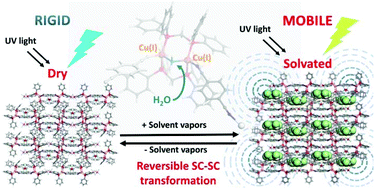Luminescent vapochromic single crystal to single crystal transition in one-dimensional coordination polymer featuring the first Cu(i) dimer bridged by an aqua ligand†
Abstract
The reaction of the pre-assembled bimetallic Cu(I) [Cu2(μ2-dppm)2]2+ fragment with the ligand 1,4-dicyanobenzene B0 in non-distilled CH2Cl2 allowed the characterisation of an unexpected one-dimensional coordination polymer D, while no reaction occurred when dry CH2Cl2 was used as the solvent. The X-ray crystal structure resolution performed on air-stable single crystals of D revealed that this coordination polymer contained the first reported bridging aqua ligand coordinated on Cu(I) bimetallic units connected by B0 ligands within zig-zag chains. Consequently, D was obtained in very good yield when the synthesis was conducted in dry CH2Cl2, in which water was added as a reactant in excess. In the solid state at room temperature under UV lamp excitation, D presented blue-cyan eye-perceived luminescence that contrasted with the green-yellow eye-perceived luminescence emitted by single crystals of D in the crystallisation solution. Related to this property, reversible luminescent vapochromic behaviour was observed upon the exposure of dry single crystals of D to vapors of CH2Cl2, EtOH, CH3NO2 and THF solvents. The X-ray crystal structure resolution analysis revealed that this vapochromic response occurs via single crystal to single crystal transitions, along which the volatile solvent molecules are taken up in the very low porous dry single crystals of D, leading to the formation of one-dimensional channels of included solvent molecules, which are mobile in the crystalline solid at room temperature. The detailed temperature -dependent photophysical studies suggest that this mobility impacts the relaxation processes within these molecular solids, resulting in luminescence vapochromic effects. The results also highlight the complexity of the relaxation processes that can take place in these heteroleptic polymetallic Cu(I) supramolecular assemblies, which are based on highly easy, affordable and quick synthetic procedures.



 Please wait while we load your content...
Please wait while we load your content...